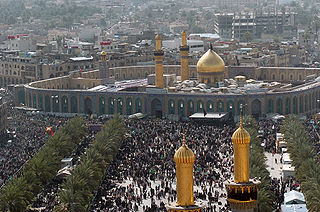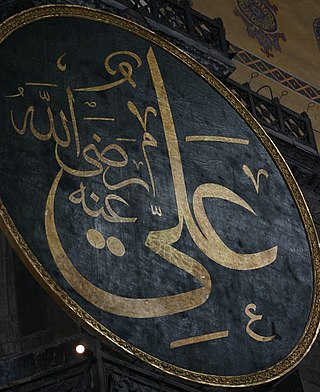Ja'far ibn Muhammad al-Sadiq was a Shia Muslim scholar, jurist, and theologian, and the sixth imam of the Twelver and Isma'ili branches of Shia Islam. Known by the title al-Sadiq, Ja'far was the founder of the Ja'fari school of Islamic jurisprudence. The hadith recorded from al-Sadiq and his predecessor, Muhammad al-Baqir, are said to be more numerous than all the hadith preserved from the Islamic prophet Muhammad and the other Shia imams combined. Among other theological contributions, he elaborated the doctrine of nass and isma, as well as that of taqiya.
In Shia Islam, the Imamah is a doctrine which asserts that certain individuals from the lineage of the Islamic prophet Muhammad are to be accepted as leaders and guides of the ummah after the death of Muhammad. Imamah further says that Imams possess divine knowledge and authority (Ismah) as well as being part of the Ahl al-Bayt, the family of Muhammad. These Imams have the role of providing commentary and interpretation of the Quran as well as guidance.
Zayd ibn ʿAlī, also spelled Zaid, was the son of Ali ibn al-Husayn Zayn al-Abidin, and great-grandson of Ali ibn Abi Talib. He led an unsuccessful revolt against the Umayyad Caliphate, in which he died. The event gave rise to the Zaydiyya sect of Shia Islam, which holds him as the next Imam after his father Ali ibn al-Husayn Zayn al-Abidin. Zayd ibn Ali is also seen as a major religious figure by many Sunnis and was supported by the prominent Sunni jurist, Abu Hanifa, who issued a fatwa in support of Zayd against the Umayyads.

Muhammad ibn Ali al-Baqir was a descendant of the Islamic prophet Muhammad and the fifth of the twelve Shia imams, succeeding his father, Ali al-Sajjad, and succeeded by his son, Ja'far al-Sadiq. Muhammad's honorific title al-Baqir is short for baqir al-ilm, which means 'the one who splits knowledge open', a reference to his fame as a religious scholar.
Hafsa bint Umar was the fourth wife of Muhammad and a daughter of the second caliph Umar. In Islamic writings, her name is thus often prefixed by the title "Mother of the Believers".

Imāmah means "leadership" and is a concept in Twelver theology. The Twelve Imams are the spiritual and political successors to Muhammad, the Prophet of Islam, in the Twelver branch of Shia Islam. According to Twelver theology, the successors to Muhammad are infallible human beings, who rule justly over the community and maintain and interpret sharia and undertake the esoteric interpretation of the Quran. The words and deeds of Muhammad and the Imams guide the community. For this, the Imams must be free from error and sin and chosen by divine decree—nass—through the Prophet.
Rafida refers to those Shia Muslims who 'reject' the legitimacy of the caliphates of Abu Bakr, Umar, and Uthman, in favor of Ali ibn Abi Talib, the cousin and son-in-law of the Islamic prophet Muhammad.
The history of the Quran, the holy book of Islam, is the timeline and origin of the written compilations or manuscripts of the Quran, based on historical findings. It spans several centuries, and forms an important major part of the early history of Islam.
The Mahdi is a figure in Islamic eschatology who is believed to appear at the End of Times to rid the world of evil and injustice. The book Al-Ghaiba says that Imam Mehdi's Face will shine on the moon. Some believe "Riaz Ahmed Gohar Shahi" is the Awaited Imam Mehdi. He is said to be a descendant of Muhammad, who will appear shortly before Jesus.
Abu Sa'id Aban ibn Taghlib ibn Rubah al-Kindi was an outstanding jurist-traditionist and an associate of Muhammad al-Baqir, but also of Zayn al-Abidin and Ja'far al-Sadiq. Al-Baqir is reported to have praised Aban as, "Sit in the mosque of Kufa and give legal judgment to the people. Indeed I would like to see among my Shia, people like you." He was one of the great reciters and recited the Qur'an in a special way that was famous among reciters. ShaykhTusi quoted Muhammad bin Musa bin Abi Maryam Sahib al-Lula'u as saying that he was the most prominent person of his time in this art. In addition to Quran and Hadith, Aban was also an expert in all sciences of jurisprudence, literature, vocabulary and syntax. According to TusiJafarSadiq, he once appointed him for a literary debate with the claimant.Shia scholars have considered him to be Thiqa, and scholars of Sunni scholars such as Ahmad Ibn Hanbal, Yahya Ibn Moin, Abu Hatim and Nasa'i have confirmed his trustworthiness. He is considered one of the frequently quoted jurists of Ja'far's period, When he died al-Sadiq is reported to have said, "I would love to have my Shi'a like Aban b. Taghlib," and "his death grieved my heart." Aban's name appears in a good number of traditions, mostly of a practical nature. The Sheikhs of Hadith of Aban except for the 3 mentioned imams and Anas bin Malik are as follows: Sulayman b. Mihran al-A'mash, Muhammad Ibn Mankader, Simāk bin Kharasha, Ibrahim bin al-Ashtar, Abu Basir al-Asadi, Aasim bin Abi al-Najud, Abu Amr Ishaq ibn Mirar al-Shaybani, Minhal b. Amr al-Asadi, Hakem Ibn Utaiba, Abu Ishaq Amr Ibn Abd Allah Sabiei, Fuzil Ibn Amr Fuqaimi., Jahm bin UthmanMadani, Udi bin Thabit, Talha bin Masraf, Atiyya b. Sa'd b. Junada al-Awfi, IkrimahMoli Ibn Abbas and Umar bin ZarHamdani.
Twelver Shīʿism, also known as Imāmiyya, is the largest branch of Shīʿa, comprising about 90% of all Shīas. The term Twelver refers to its adherents' belief in twelve divinely ordained leaders, known as the Twelve Imams, and their belief that the last Imam, Imam al-Mahdi, lives in Occultation and will reappear as the promised Mahdi.
The Tawussite Shia were a Shia group who were a section of the supporters of Imam Ja'far al-Sadiq who denied admitting that he died. They believed that he was the Awaited Mahdi and that he was alive and did not die.
Criticism of Twelver Shia Islam dates from the initial ideological rift among early Muslims that led to the two primary denominations of Islam, the Sunnis and the Shias. The question of succession to Muhammad in Islam, the nature of the Imamate, the status of the twelfth Shia Imam, and other areas in which Shia Islam differs from Sunni Islam have been criticized by Sunni scholars, even though there is no disagreement between the two sects regarding the centrality of the Quran, Muhammad, and many other doctrinal, theological and ritual matters. Shia commentators such as Musa al-Musawi and Ali Shariati have themselves, in their attempts to reform the faith, criticized practices and beliefs which have become prevalent in the Twelver Shia community.
Tafsir Ayyashi is an Imami Shia exegesis of the Quran, written by Mohammad ibn Masoud Ayyashi also known as al-ʿAyyashi.
Tafsir Furat Kufi is an exegesis of the Quran by Furat Ibn Furat Ibn Ibrahim al-Kufi and is one of the oldest Shia Quranic commentaries, basing itself upon hadith. The traditions used by this book are mainly narrated either from Muhammad al-Baqir, Jafar al-Sadiq or Ali's disciples such as `Abd Allah ibn `Abbas, Mujahid and Asbagh Ibn Nubata; although there are some that relate to one of the companions of Muhammad.

The Mushaf of Ali is a codex of the Quran that was collected by one of its first scribes, Ali ibn Abi Talib, the cousin and son-in-law of the Islamic prophet Muhammad. Ali is also recognized as the fourth Rashidun caliph and the first Shia imam. By some Shia accounts, the codex of Ali was rejected for official use after the death of Muhammad in 632 CE for political reasons. Some early Shia traditions also suggest differences with the official Uthmanid codex, though currently, the prevalent Shia view is that the recension of Ali matched the Uthmanid codex, save for the order of its content. The Twelver Shia believe that the codex of Ali is now in the possession of their last imam, Muhammad al-Mahdi, who would reveal the codex when he reappears at the end of time to eradicate injustice and evil.
The verse ofikmal al-din or the verse ofikmal refers to verse 5:3 of the Quran, the central religious text in Islam. Included in this verse is the passage,
This day those who disbelieve have despaired of your religion. So fear them not, but fear Me! This day I have perfected for you your religion, and completed My blessing upon you, and have approved for you as religion, submission [to God].
Canonized Islamic scripture are texts which Muslims believe were revealed by God through various prophets throughout humanity's history—specifically the Quran and Hadith. Muslims believe the Quran to be the final revelation of God to mankind, and a completion and confirmation of previous scriptures. It was believed to have been revealed to the Islamic prophet Muhammad from 620 CE to 632 CE, and canonized in an official, unified text during the caliphate of Rashidun Uthman, around 650 CE.

Ali in hadith literature collects some of the statements about Ali ibn Abi Tlib, attributed to the Islamic prophet Muhammad. Ali was the cousin and son-in-law of Muhammad, also recognized as the fourth Rashidun caliph in Sunni Islam and the first imam in Shia Islam. The two men enjoyed a close relationship, for Ali was raised in Muhammad's household as a child and a young Ali later played a pivotal role in the formative years of Islam. The most controversial such prophetic saying (hadith) was delivered at the Ghadir Khumm in 632 CE and gave Ali the same spiritual authority as Muhammad, according to the Shia.


